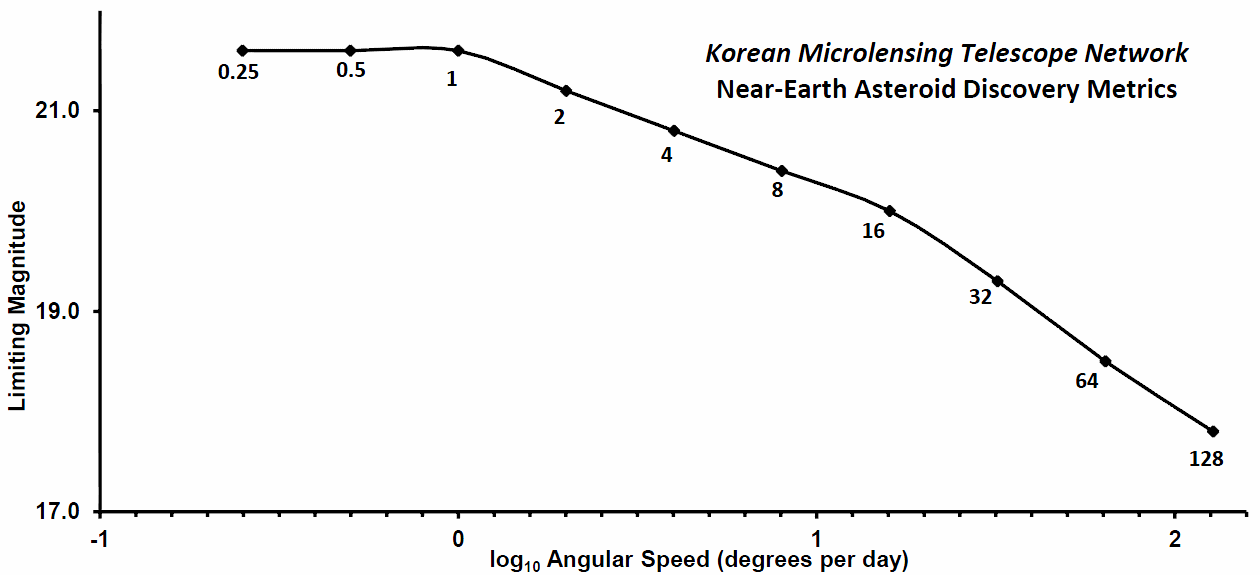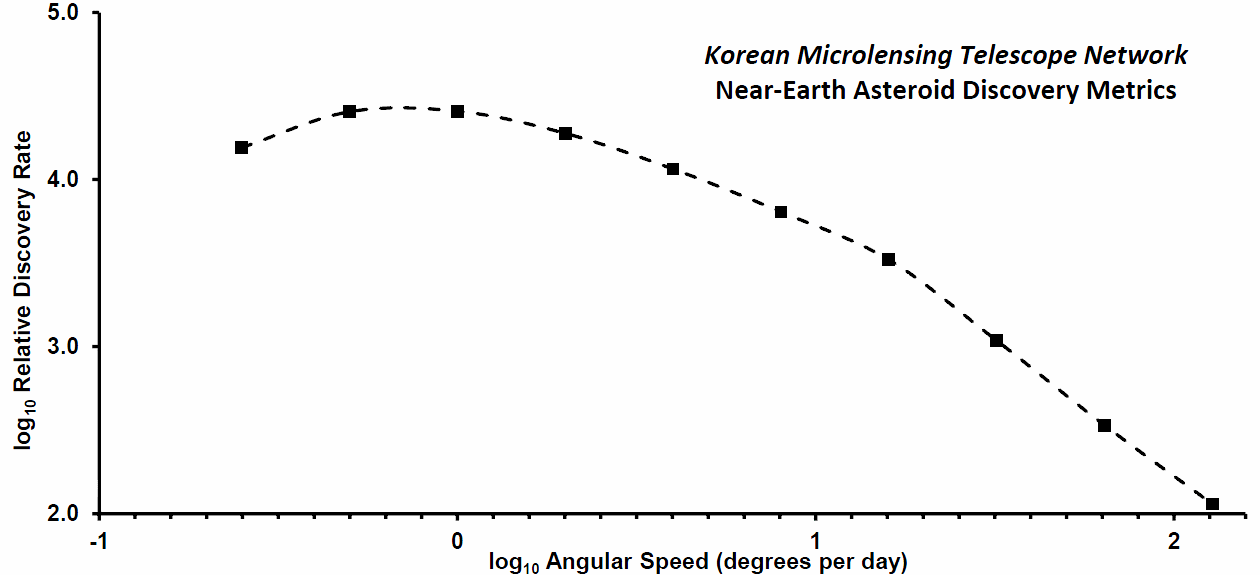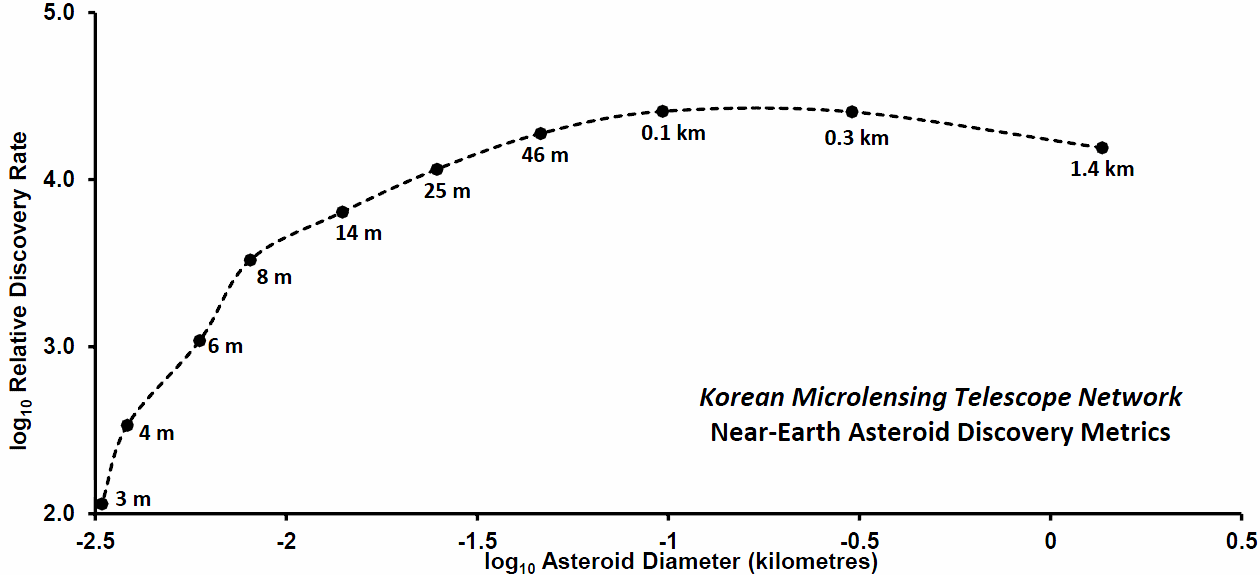Asteroid discovery efficiencies for the
Korean Microlensing Telescope Network
Duncan Steel
2015 May 19
Introduction
The Korean Microlensing Telescope Network (KMTNet) is planned to include three telescopes located in the Southern Hemisphere in a project aimed at the identification of Earth-mass planets orbiting other stars through gravitational lensing effects. The telescopes are to be located in Chile, South Africa and Australia.
The telescopes will have an aperture of 1.6 metres, and a field of view (FOV) covering about four square degrees which will be imaged using a 340 megapixel CCD camera. The intent is to obtain repeated images of four adjacent fields near the Galactic Bulge, with 24-hour coverage being possible in principle from these three observatory sites. The variation in light intensity received due to transient events may then indicate the presence of extrasolar planets, as described above.
The preceding two paragraphs comprise a brief (and inadequate) summary of the aims of KMTNet. The intent here, in this paper, is simply to indicate the possible effectiveness of the KMTNet telescopes for the discovery of near-Earth asteroids (NEAs). No specific data collection is envisioned; I am just exploring how often NEAs might be detected in KMTNet imagery routinely collected for the purposes of that project, should the imagery be processed to this end in a timely manner using suitable moving-object algorithms.
Gould and Yee have pointed out that microlensing surveys such as KMTNet will render a huge volume of useful data on main-belt asteroids. It is emphasized that here I am considering only NEA discoveries and not the far larger number of discoveries (and invaluable information on spin rates etc.) of main-belt asteroids that will be spawned by KMTNet and the like.
Current NEA search programs
Simply as background for the interested reader, I point out that ongoing NEA search programs are listed here. A notable new project due to commence at the end of this year is ATLAS. Note that ATLAS (that’s a different link) will make use of quite small telescopes (aperture near 50 cm) but will cover large areas of the sky.
Asteroid discovery efficiency metric
Twenty years ago I studied the feasible NEA discovery efficiencies for telescope systems at Siding Spring Observatory (SSO), and a few other systems, plus plausible NEA discovery efficiencies should suitable CCD cameras be installed on various systems at SSO. My analysis (the paper in question is available by clicking here; 1.85 MB PDF) was based on a method developed by Al Harris.
Subsequently (and consequently) the Uppsala Southern Schmidt Telescope at SSO was modernized and equipped with a CCD system, as part of the University of Arizona Catalina Sky Survey, and proved to be a highly-effective device for the discovery of NEAs and comets. Its limited aperture (0.6 metres), however, has meant that as the majority of large NEAs (1 km and above) have been found its utility has passed.
Larger aperture systems are now required, for the discovery of smaller NEAs (see this report from 2011, and for more up-to-date information see the various papers presented at the Planetary Defense conferences held in 2013 and 2015). Deliberate, dedicated searches are under way. However, there are also other astronomical surveys being conducted which will inadvertently turn up NEAs – astrophysicists have been known to term asteroids the “vermin of the skies” – and KMTNet is an example of one of the surveys.
All I have done here is to resurrect my software from two decades ago, and input the relevant parameters for the KMTNet systems. It is emphasized that I have not updated, say, the asteroid population model that I have used, as introduced by Harris; it would be useful if someone could perform such an update, and make use of the experiences obtained in the various NEA search programs over the past twenty years.
KMTNet systems parameters
I am indebted to Dr Michael Albrow for information regarding the KMTNet CCD cameras. The relevant parameters for the present analysis are as follows:
Detector system: 2 x 2 mosaic of 9k x 9k E2V 290-99 CCDs.
Nominal FOV: 2 degrees x 2 degrees.
Pixel angular width: 0.39 arcseconds.
(Note that 9,000 x 0.39 arcsecond pixels indicates a FOV 1.95
degrees wide; and this is the FOV I have used.)
The other input parameters to the NEA discovery efficiency software are as below:
CCD quantum efficiency: 0.8 (assumed value).
Minimum signal-to-noise ratio for asteroid detection: 6 (six).
Exposure duration: 60 seconds.
Exposures per hour: 24 (i.e. a duty cycle of 40 per cent).
Because there are four fields (each of four square degrees) being
repeatedly imaged, each of those fields is imaged six times per
hour.
Telescope effective aperture: 1.3 metres
(The actual telescope aperture is 1.6 metres, but the central
obstructions cut down the effective collector area. I have assumed
that about two-thirds of the aperture is free of obstruction:
[1.3/1.6]² ≅ 0.66.)
Results
Using the above input parameters I obtained results as shown in Figures 1-3 below. It is intended that these plots should be compared with Figures 2, (3 & 5) and (4 & 6) respectively in my previous paper.
 Figure 1: The limiting (asteroid) magnitude obtainable as a function of asteroidal angular speed between 0.25 and 128 degrees per day.
Figure 1: The limiting (asteroid) magnitude obtainable as a function of asteroidal angular speed between 0.25 and 128 degrees per day.
 Figure 2: The logarithmic relative discovery rate as a function of asteroidal angular speed .
Figure 2: The logarithmic relative discovery rate as a function of asteroidal angular speed .
Figure 3: The logarithmic relative discovery rate as a function of asteroid equivalent diameter.
Discussion
If one compares the above plots with my previous results, there are few surprises in terms of the general form of the curves. The most pertinent results to compare with are those I derived for the GEODSS cameras, actually before they were brought into use for NEA detection. For these 1-metre aperture systems, assuming 30-second exposures, I found that the discovery efficiencies indicated are about eight to ten times higher than those found here for individual KMTNet telescopes, with relative discovery curves having shapes very similar to those in Figures 2 and 3 above.
Why are the KMTNet telescopes indicated to have lower NEA discovery efficiencies? There are several contributing considerations, as follows.
- With 60-second exposures and 0.39-arcsecond pixels, only the slowest-moving NEAs will be pseudo-stationary (in the terminology of my earlier paper); those moving at one to eight degrees per day will produce short trails in the KMTNet images, while those travelling at angular speeds of 16 deg/day will result in long-trailed images, and there is no benefit in having trailed images, as such, in terms of moving object identification.
- By repeatedly imaging the same fields, rather than covering new areas of the sky, the KMTNet observing routine will produce multiple detections of the same NEAs rather than a large number of discoveries; this has some advantages, in that the KMTNet system in effect will be doing its own ‘follow-up’ of NEA positions within each night (and over several nights for the NEAs moving at less than 2 deg/day), resulting in astrometric arcs lasting several days for most of its NEA discoveries, and this will be highly advantageous in view of the sparsity of asteroid follow-up astrometry in the Southern Hemisphere.
- After the original NASA Spaceguard Goal (covering 1-km NEAs) was nominally achieved, the target sizes were dropped first to 140-metres, and now lower still. Consideration of Figure 3 indicates that the KMTNet systems will provide for peak discovery efficiencies in the 50 to 300 metre size range, and it will be these-sized NEAs that are moving quickly enough to replenish the FOV of the KMTNet cameras from night-to-night.
- Systems like ATLAS will cover smaller sizes still, but not much; KMTNet will have substantial discovery efficiencies for NEAs in the 20- to 50-metre size range (smaller asteroids, such as the Chelyabinsk object, cause relatively little damage on impact) and, since KMTNet will be operated with self-consistent observing routines and directed at only a small region of the sky, it might be anticipated that the analysis of results from KMTNet will be of especial interest in terms of developing improved understandings of the population and orbital distribution of small NEAs and therefore their impact frequency on Earth.
Acknowledgement: I thank Dr Michael Albrow for discussions and correspondence regarding KMTNet.
